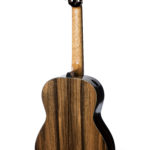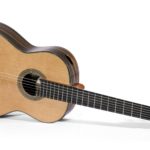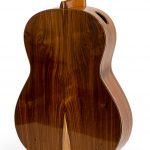The “Tradizione” guitar is an instrument sporting exclusively a spruce soundboard, back and sides made of maple, cypress or rosewood. It is a light and resonating instrument. It is small and it is inspired by Antonio de Torres’ guitars and by the Spanish luthiers from the early 1900s, such as Enrique García, Manuel Ramírez, and Santos Hernández among others. Tradizione guitars have deep bass, a wide timbre palette, and a special cantabile.
The making of this piece traces the Spanish method, with its traditional neck joint, soundboard with fan bracing, mosaic rosette and shellac varnish (French polish).


























